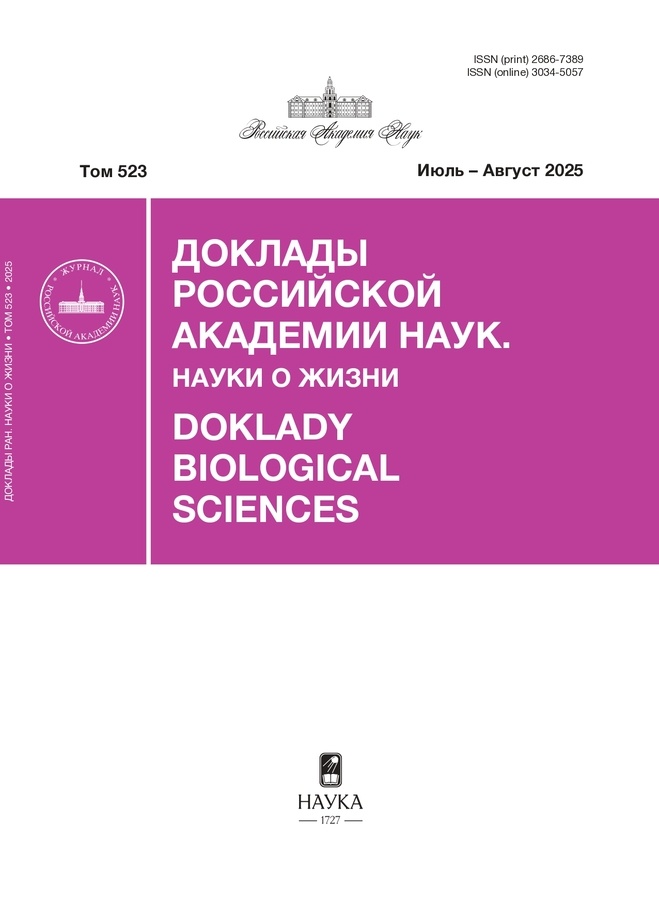Полиморфизм меланофилина у хорьков разного окраса
- Авторы: Косовский Г.Ю.1, Глазко В.И.1, Абрамов О.И.1, Глазко Т.Т.1
-
Учреждения:
- ФГБНУ Научно-исследовательский институт пушного звероводства и кролиководства им. В.А. Афанасьева
- Выпуск: Том 514, № 1 (2024)
- Страницы: 101-106
- Раздел: Статьи
- URL: https://gynecology.orscience.ru/2686-7389/article/view/651474
- DOI: https://doi.org/10.31857/S2686738924010197
- EDN: https://elibrary.ru/KHDSXD
- ID: 651474
Цитировать
Полный текст
Аннотация
У млекопитающих основной вклад в изменчивость пигментации вносят две группы генов, непосредственно связанные с метаболическими путями синтеза пигментов и контролирующие транспорт в меланоцитах меланосом к кератиноцитам. С целью выявления генетических основ вариантов такой изменчивости выполнено сравнение нуклеотидных последовательностей гена меланофилина у двух групп хорьков – серебристого окраса и животных дикого типа с использованием секвенирования 16 экзонов. У носителей серебристого окраса выявлена мононуклеоидная делеция в 9-м экзоне, приводящая к сдвигу рамки считывания и образованию ниже по течению стоп-кодона. Мутантный белок почти полностью лишен С концевого домена, ответственного за контакт меланосом с актином при их продвижении к периферии меланоцитов, но сохраняет лидирующий домен, участвующий в формировании меланосом. Сочетание сохранности N домена и дефекта C домена мутантного белка впервые позволяет объяснить неполное доминирование белка дикого типа у гетерозигот.
Ключевые слова
Полный текст
Об авторах
Г. Ю. Косовский
ФГБНУ Научно-исследовательский институт пушного звероводства и кролиководства им. В.А. Афанасьева
Автор, ответственный за переписку.
Email: gkosovsky@mail.ru
член-корреспондент
Россия, Московская обл., Раменский р-н, пос. РодникиВ. И. Глазко
ФГБНУ Научно-исследовательский институт пушного звероводства и кролиководства им. В.А. Афанасьева
Email: gkosovsky@mail.ru
Россия, Московская обл., Раменский р-н, пос. Родники
О. И. Абрамов
ФГБНУ Научно-исследовательский институт пушного звероводства и кролиководства им. В.А. Афанасьева
Email: gkosovsky@mail.ru
Россия, Московская обл., Раменский р-н, пос. Родники
Т. Т. Глазко
ФГБНУ Научно-исследовательский институт пушного звероводства и кролиководства им. В.А. Афанасьева
Email: gkosovsky@mail.ru
Россия, Московская обл., Раменский р-н, пос. Родники
Список литературы
- Ermini L., Francis J. C., Rosa G. S., et al. Evolutionary selection of alleles in the melanophilin gene that impacts on prostate organ function and cancer risk // Evol Med Public Health. 2021. V. 9 (1). P. 311–321.
- Alshanbari F., Castaneda C., Juras R., et al. (2019) Comparative FISH-Mapping of MC1R, ASIP, and TYRP1 in New and Old World Camelids and Association Analysis With Coat Color Phenotypes in the Dromedary (Camelus dromedarius) // Front Genet. 2019. V. 10. P. 340.
- Jia X., Ding P., Chen S., et al. Analysis of MC1R, MITF, TYR, TYRP1, and MLPH Genes Polymorphism in Four Rabbit Breeds with Different Coat Colors // Animals (Basel). 2021. V. 11 (1). P. 81.
- Vaez M., Follett S. A., Bed'hom B., et al. A single point-mutation within the melanophilin gene causes the lavender plumage colour dilution phenotype in the chicken // BMC Genet. 2008. V. 9. P. 7.
- Bed'hom B., Vaez M., Coville J. L., et al. The lavender plumage colour in Japanese quail is associated with a complex mutation in the region of MLPH that is related to differences in growth, feed consumption and body temperature // BMC Genomics.2012. V. 13. P. 442.
- Bauer A., Kehl A., Jagannathan V., et al. A novel MLPH variant in dogs with coat colour dilution. Anim Genet. 2018. V. 49 (1). P. 94–97.
- Demars J., Iannuccelli N., Utzeri V. J., et al. New Insights into the Melanophilin (MLPH) Gene Affecting Coat Color Dilution in Rabbits // Genes (Basel). 2018. V. 9 (9). P. 430.
- Ishida Y., David V. A., Eizirik E., et al. A homozygous single-base deletion in MLPH causes the dilute coat color phenotype in the domestic cat // Genomics. 2006. V. 88 (6). P. 698–705.
- Cirera S., Markakis M. N., Christensen K., et al. New insights into the melanophilin (MLPH) gene controlling coat color phenotypes in American mink // Gene. 2013. V. 527 (1). P. 48–54.
- Manakhov A. D., Andreeva T. V., Trapezov O. V., Kolchanov N. A., Rogaev E. I. Genome analysis identifies the mutant genes for common industrial Silverblue and Hedlund white coat colours in American mink // Sci Rep. 2019. V. 9 (1). P. 4581.
- Li W., Sartelet A., Tamma N., et al. Reverse genetic screen for loss-of-function mutations uncovers a frameshifting deletion in the melanophilin gene accountable for a distinctive coat color in Belgian Blue cattle // Anim Genet. 2016. V. 47 (1). P. 110–113.
- Posbergh C. J., Staiger E. A., Huson H. A Stop-Gain Mutation within MLPH Is Responsible for the Lilac Dilution Observed in Jacob Sheep // Genes (Basel). 2020. V. 11 (6). P. 618.
- Kalds P., Zhou S., Gao Y., et al. Genetics of the phenotypic evolution in sheep: a molecular look at diversity-driving genes // Genet Sel Evol. 2022. V. 54 (1). P. 61.
- Lehner S., Gähle M., Dierks C., et al. Two-exon skipping within MLPH is associated with coat color dilution in rabbits // PLoS One. 2013. V. 8 (12). P. e84525.
- Fontanesi L., Scotti E., Allain D., et al. A frameshift mutation in the melanophilin gene causes the dilute coat colour in rabbit (Oryctolagus cuniculus) breeds // Anim Genet. 2013. V. 45 (2). P. 248–55.
- Demars J., Iannuccelli N., Utzeri V. J., et al. New Insights into the Melanophilin (MLPH) Gene Affecting Coat Color Dilution in Rabbits // Genes (Basel). 2918. V. 9 (9). P. 430.
- Hume A. N., Tarafder A.K, Ramalho J. S., et al. A coiled-coil domain of melanophilin is essential for Myosin Va recruitment and melanosome transport in melanocytes // Mol Biol Cell. 2006. V. 17 (11). P. 4720–4735.
Дополнительные файлы












